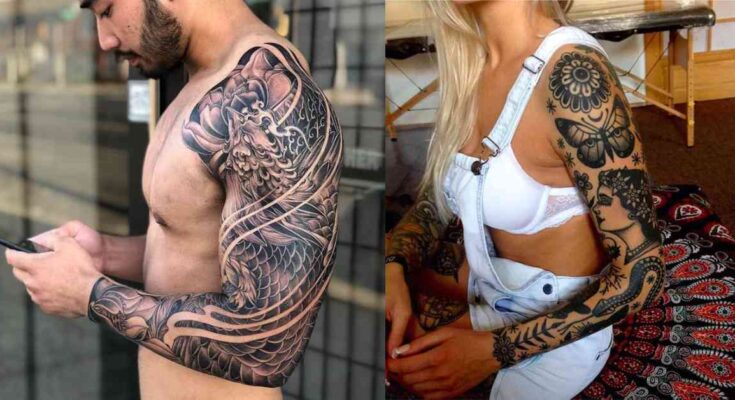Introduction
Sleeve tattoos have gained immense popularity over the years, becoming a significant part of the body art culture. These intricate and extensive pieces of artwork cover a large portion of the arm, often from the shoulder down to the wrist, creating a visually captivating canvas. Whether you’re considering getting your first sleeve tattoo or simply interested in learning more about this fascinating art form, this comprehensive guide will provide you with everything you need to know about sleeve tattoos.
History of Sleeve Tattoos
The history of sleeve tattoos is as rich and varied as the designs themselves. Tattoos have been a part of human culture for thousands of years, with evidence of their existence found in ancient civilizations such as the Egyptians, Greeks, and Romans. However, the concept of sleeve tattoos, specifically, can be traced back to Japanese tattoo art, known as Irezumi.
In Japan, full-body tattoos, including sleeves, were often worn by members of the Yakuza, the Japanese mafia, as a symbol of loyalty and strength. These tattoos, often featuring intricate designs of dragons, koi fish, and samurai, were done using traditional hand-poking techniques, a process that was both time-consuming and painful.
In the Western world, sleeve tattoos began to gain popularity in the late 20th century. The counterculture movements of the 1960s and 1970s, along with the rise of punk and heavy metal music, played a significant role in popularizing tattoos as a form of self-expression. Today, sleeve tattoos are a mainstream phenomenon, embraced by people from all walks of life.
Types of Sleeve Tattoos
Sleeve tattoos come in various styles and designs, each with its unique appeal. Here are some of the most popular types of sleeve tattoos:
1. Full Sleeve Tattoos
A full sleeve tattoo covers the entire arm, from the shoulder to the wrist. These tattoos are often highly detailed and intricate, requiring multiple sessions to complete. Full sleeve tattoos can be a cohesive design or a collection of smaller, interconnected pieces.
2. Half Sleeve Tattoos
A half sleeve tattoo covers the upper arm, from the shoulder to the elbow, or the lower arm, from the elbow to the wrist. This option is ideal for those who want a significant amount of tattoo work but may not be ready to commit to a full sleeve.
3. Quarter Sleeve Tattoos
A quarter sleeve tattoo typically covers the area from the shoulder to midway down the upper arm. This is a great option for those who want a more subtle piece that can be easily covered if needed.
4. Patchwork Sleeve Tattoos
Patchwork sleeve tattoos are composed of smaller, individual tattoos that are gradually added over time. This style allows for more flexibility in design and can be a great way to incorporate a variety of themes and elements.
Popular Styles and Themes
When it comes to sleeve tattoos, the possibilities are endless. Here are some of the most popular styles and themes:
1. Traditional (Old School)
Traditional tattoos, also known as old school tattoos, are characterized by bold lines, vibrant colors, and iconic imagery such as anchors, roses, and pin-up girls. This style has a timeless appeal and is often chosen for its nostalgic and classic look.
2. Neo-Traditional
Neo-traditional tattoos build upon the traditional style but incorporate more intricate details, a broader color palette, and modern elements. This style often features realistic shading and depth, creating a more three-dimensional appearance.
3. Japanese (Irezumi)
Japanese tattoos are renowned for their intricate designs and deep cultural significance. Common motifs include dragons, koi fish, cherry blossoms, and samurai warriors. These tattoos often cover large areas of the body and are known for their vibrant colors and bold outlines.
4. Black and Grey
Black and grey tattoos use only black ink and varying shades of grey to create stunning, monochromatic designs. This style is particularly popular for portraits, realistic imagery, and intricate patterns.
5. Biomechanical
Biomechanical tattoos combine elements of machinery and human anatomy, creating the illusion of robotic parts beneath the skin. This futuristic style is highly detailed and often features intricate shading and realistic textures.
6. Realism
Realistic tattoos aim to replicate lifelike images on the skin, often depicting portraits, animals, or nature scenes. This style requires a high level of skill and precision, making it one of the most impressive and challenging forms of tattoo art.
7. Abstract
Abstract tattoos are less about representing specific images and more about creating unique, artistic designs. This style can include geometric patterns, watercolor effects, and surreal imagery, allowing for endless creative possibilities.
Planning Your Sleeve Tattoo
Getting a sleeve tattoo is a significant commitment, both in terms of time and money. Proper planning is essential to ensure that you end up with a piece of art that you will cherish for a lifetime. Here are some steps to consider:
1. Research and Inspiration
Before getting a sleeve tattoo, take the time to research different styles and gather inspiration. Look at portfolios of tattoo artists, browse online galleries, and consider the themes and elements that resonate with you. Creating a mood board can be a helpful way to visualize your ideas.
2. Choosing a Tattoo Artist
Selecting the right tattoo artist is crucial to the success of your sleeve tattoo. Look for an artist who specializes in the style you want and has a strong portfolio of work. Schedule a consultation to discuss your ideas and ensure that you feel comfortable with the artist’s approach and expertise.
3. Design and Layout
Work closely with your chosen tattoo artist to design your sleeve tattoo. Consider how the different elements will flow together and how the design will complement the natural contours of your arm. Be open to your artist’s suggestions, as they have the experience to know what will work best.
4. Scheduling Sessions
Sleeve tattoos typically require multiple sessions to complete, especially if the design is highly detailed. Discuss the timeline with your artist and plan your sessions accordingly. Be prepared for a significant time commitment, as each session can take several hours.
5. Budgeting
Sleeve tattoos can be expensive, with costs varying depending on the artist’s experience, location, and the complexity of the design. Set a budget and discuss pricing with your artist upfront. Remember that quality work is worth the investment.
The Tattooing Process
Understanding the tattooing process can help you prepare for what to expect during your sessions. Here’s a general overview:
1. Consultation
During the consultation, you will discuss your ideas with the tattoo artist, review their portfolio, and collaborate on the design. This is also the time to ask any questions and address any concerns you may have.
2. Design Approval
Once the design is finalized, the artist will create a stencil to ensure the placement and proportions are correct. You will have the opportunity to approve the design before the tattooing begins.
3. Tattooing
The actual tattooing process involves several steps:
- Outlining: The artist will start by outlining the design with a tattoo machine, using a single needle or a group of needles. This step establishes the basic structure of the tattoo.
- Shading: After the outline is complete, the artist will add shading to create depth and dimension. This step may involve different techniques, such as stippling or smooth shading.
- Coloring: If your tattoo includes color, the artist will apply it after the shading is done. Multiple layers of color may be added to achieve the desired vibrancy and detail.
4. Aftercare
Proper aftercare is crucial to the healing process and the longevity of your tattoo. Your artist will provide detailed instructions, which typically include:
- Keeping the tattoo clean and dry
- Applying a thin layer of ointment or tattoo-specific aftercare product
- Avoiding direct sunlight and swimming
- Refraining from picking or scratching the tattoo
Pain and Healing
The pain associated with sleeve tattoos varies depending on individual pain tolerance and the specific area of the arm being tattooed. Generally, areas with more muscle and fat, such as the upper arm, tend to be less painful, while areas with thinner skin and more bone, like the elbow and wrist, can be more sensitive.
The healing process typically takes 2-4 weeks, during which time you may experience redness, swelling, and itching. It’s important to follow your artist’s aftercare instructions to prevent infection and ensure proper healing.
Sleeve Tattoo Maintenance
To keep your sleeve tattoo looking vibrant and fresh, regular maintenance is essential. Here are some tips:
- Moisturize: Keep your skin hydrated by applying a fragrance-free moisturizer regularly.
- Sun Protection: Protect your tattoo from UV rays by applying sunscreen with a high SPF.
- Touch-Ups: Over time, tattoos can fade or become less defined. Schedule touch-up sessions with your artist as needed to maintain the quality of your tattoo.
Pros and Cons of Sleeve Tattoos
Like any major decision, getting a sleeve tattoo has its pros and cons. Here are some to consider:
Pros:
- Artistic Expression: Sleeve tattoos allow for a high level of creativity and personalization.
- Visual Impact: A well-executed sleeve tattoo can be a stunning piece of body art.
- Cultural Significance: Tattoos can hold deep personal and cultural meaning.
Cons:
- Cost: Sleeve tattoos can be expensive, especially for high-quality work.
- Time Commitment: Completing a sleeve tattoo requires multiple sessions over an extended period.
- Pain: The tattooing process can be painful, particularly in sensitive areas.
- Maintenance: Tattoos require ongoing care and protection to keep them looking their best.

Conclusion
Sleeve tattoos are a powerful form of self-expression and a testament to the skill and artistry of tattoo artists. Whether you’re drawn to traditional designs, modern styles, or something entirely unique, a sleeve tattoo can be a meaningful and visually stunning addition to your body. By understanding the history, styles, and process of sleeve tattoos, you can make an informed decision and embark on a rewarding journey into the world of body art.




